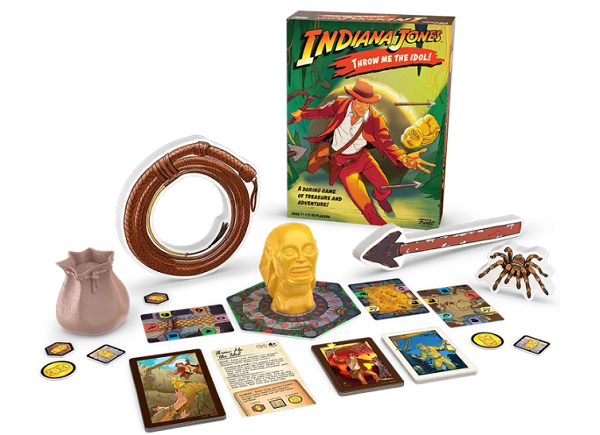Indiana Jones: Throw Me the Idol! - A Game of Speed, Dexterity, and Treasure

Have your teammates talk you towards finding hidden objects while blindfolded, or throw an arrow over your shoulder at your opponent with the help of a mirror before they can steal the idol.
Published by Funko Games, and designed for 2-10 players, Indiana Jones: Throw Me the Idol! offers both speed and dexterity challenges.
Gameplay
Players split into two teams and take their team’s stack of temple cards. Each round is split into two phases. During phase one, the idol chamber tile is placed in the center of the table and the idol placed on top of it. A player is chosen on each team to be the explorer for that round.
The explorer draws the top card of his team’s temple cards and places it roughly two feet from the idol tile, face-up. Each temple card shows a series of icons along the edges of the card. Next, the explorer places three cards face-down, below the card he just played, to form a display. When players are ready, both explorers start acting simultaneously, flipping the three cards in their displays. As explorer, you choose one of the three cards to play, placing it adjacent to the card you already have on the table. In order to play a card adjacent to it, at least one icon on both cards must match and line up, and the new card cannot overlap any other cards. A new card is then added to your display, and you continue playing cards. The other players on an explorer’s team cannot play cards, but they can draw and fill the displays, make suggestions, and point out icon matches.
The goal is to make a series of cards that reaches the idol chamber tile. The first explorer to legally play a card that overlaps any portion of the tile grabs the idol and wins the phase. The winning team takes a scoring token.
Next, players move on to the second phase of the game: the challenges. Both teams participate in some form in the challenges, although the team that won the first phase often has an advantage, such as choosing between two roles in the challenge or getting to go first. Often, both teams have an opportunity to score, while in a few instances, only the winners of the first phase do.
An example challenge is the trap floor challenge. One player from the team that won the first phase is the seeker, who balances the golden idol on the palm of his hand and puts on the blindfold. The other team places the arrow, sandbag, and tarantula components around the room within five feet of the seeker. A 30-second timer is started. The seeker’s teammates attempt to use only words to guide the seeker to touch each item. The number of items the seeker manages to reach before running out of time or dropping the idol determines how high a score token the team gets to take.
Players go through three rounds (during the final round, challenge cards are worth double the usual number of points) and the team with the highest score wins.

Review
Indiana Jones: Throw Me the Idol! is a motley mixture of mechanics. On the one hand, you have the real-time, icon-matching phase of each round, laying out cards to make a path to the idol tile, while the second half of each round is a dexterity-based physical mini-game that you play away from the table.
Both halves of the game are enjoyable. It’s a fun race to lay out your cards, and the fact that your teammates can help by drawing and flipping cards for you, or shouting suggestions, ensures that everyone still feels involved even when it’s not your turn to play the cards. The exception to this is when you're playing at the maximum player count. Five players on the same team are not all going to be able to participate during this phase.
The mini-games are imaginative and fun, and the designers have come up with a fun array of games that work with a small collection of components, and which feel thematically appropriate. It’s also fun that many of them require you to move around or to get down on the floor, making it a very physical game.
However, we did wish there were a few more challenge cards. It felt like the need to give both teams a role in every challenge card might have made it difficult to come up with enough mini-games: 12 just feels a little on the low side, especially if you really like the game and end up playing it a lot. Some challenges also require you to have components that are not included in the game, such as a timer or a mirror (yes, you can use a phone for either, but a game should still provide all the items you need to actually play it).
But while the two separate pieces of the game are enjoyable, they never quite feel like they mesh very well into a cohesive whole. It feels like they had two separate, solid ideas, and tried to force them together.
Indiana Jones: Throw Me the Idol! has some good ideas and fun components to play with, and some of the challenges are a hoot to try, while the card phase is also enjoyable. But between the two very different rounds and the lack of challenge cards, the game just doesn’t quite click into place.
Pros: Fun variety in the challenges, both separate phases are enjoyable, fun components
Cons: Not enough challenge cards, the two rounds feel too different and disconnected, not all components needed for challenges are included in the game
Disclosure: we received a complimentary review copy of this game.







